The negatives and positives for shares
Global shares mostly rose over this last week but had a messy ride.
While US shares rose, helped by the end of the Government shutdown, the gain was almost erased later in the week as hawkish commentary by some Fed officials saw market expectations for a December rate cut fall back to around 50/50, and as valuation concerns weighed on tech/AI-related stocks.
Eurozone and Japanese shares also rose, but with gains curtailed later in the week following the US lead. Australian shares fell for the third week in a row with a fall of around 1.5% as expectations for RBA rate cuts were further curtailed following stronger than expected jobs data, and as the fall in US shares later in the week weighed.
Falls for the week were led by IT, financial, property, telcos and retail shares. Bond yields mostly rose slightly, but particularly in Australia as RBA rate cut expectations were further wound back.

After an overdue correction into late October, gold prices have recovered some of their losses.
Gold is vulnerable to a further correction but should ultimately be supported by geopolitical tensions and concerns that governments may attempt to inflate their way out of high public debt levels.
By contrast Bitcoin has continued to fall and is down more than 20% from its October high and appears to be getting hit more by reduced expectations for Fed rate cuts. Metal and iron ore prices rose over the last week. A fall in the $US and reduced prospects for RBA rate cuts saw the $A rise.

The negatives and positives for shares. November so far has seen a pretty wobbly ride for shares. From their October highs US shares are down 2.2% and Australian shares are down around 5%.
The negatives for shares remain around: expensive valuations; worries about a bubble in AI shares and the excessive reliance of the US share market on them; uncertainty around how much central banks will cut interest rates notably in the US and Australia; uncertainty around the lagged impact of Trump’s tariffs; excessive public debt levels in several countries; and ongoing geopolitical risks.
Against this though: profits notably in the US are still rising strongly; the further trade truce between the US and China has reduced risk on this front for a while; the US government shutdown is now over and shares often rise after they end; Democrat victories in recent US elections increase the pressure on Trump to pivot towards more consumer friendly policies with measures to reduce “cost of living” pressures; measures of investor sentiment are not showing the euphoria often associated with major market tops and bubbles don’t normally burst when there is so much talk about them; and we are now entering a positive period of the year for shares from a seasonal perspective.
So while the risk of a further pullback in shares is high, a more severe fall may not come till next year.
2026 is another mid-term election year in the US and out of interest since 1950 US shares have had an average top to bottom drawdown of 17% in mid-term election years.
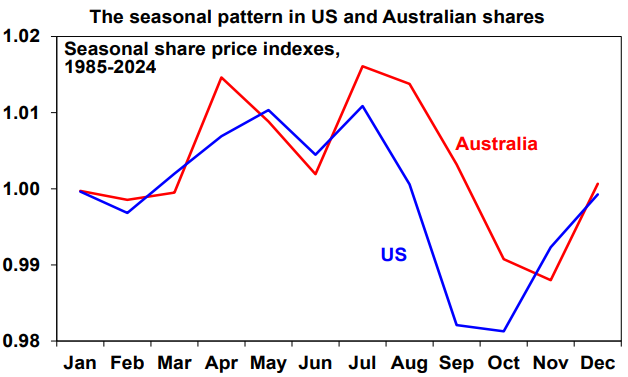
The partial US government shutdown ends after 43 days, making it the longest on record as eight moderate Democrat senators sided with Republicans to vote for funding out to 30 January.
The reopening means that any lost economic activity will be largely made up for in the months ahead as federal workers get back pay and federal mass firings are reversed as part of the deal to reopen the government and that economic data will start to be released again.
However, it will likely see a bit of volatility in economic data. And some survey based data for October - eg regarding unemployment and the CPI - will likely not be released as the surveys were not undertaken and so will get combined with November data.
While the Democrats failed to achieve their desired extension of health insurance subsidies the issue will come up again with a Senate vote on the issue (with low prospects it will be supported) and the next shutdown deadline on 30 January by which time there might be even more popular support for the issue as many Americans see their health insurance premiums rise sharply at year end.
But by then the Trump Administration will likely also be more focused on measures to ease “cost of living” pressures, given next year’s mid-term elections and the clear message from the various elections last week showing a backlash against Trump.
Australian economic data released over the last week has likely reinforced the RBA’s caution on rates. RBA Deputy Governor Hauser reiterated the RBA’s cautious stance on interest rates on the back of concerns that capacity constraints – not helped by poor productivity growth – are limiting how fast the economy can grow without leading to excessive inflation.
While he didn’t rule out further rate cuts if the September quarter inflation spike proves to be temporary and the jobs market turns out to be weaker than the RBA thinks, the RBA’s hurdle to further cuts is clearly now high.
And most of the data released over the last week support a rates on hold scenario for now - with jobs growth up and unemployment down in October, a strong rise in consumer confidence, solid business conditions and confidence readings and very strong growth in housing finance in the September quarter, reinforcing that RBA rate cuts have got traction.
However, while the RBA’s hurdle for another rate cut is high we remain of the view that the RBA will need to cut again next year as the September quarter spike in underlying inflation is likely to prove largely temporary with business surveys pointing to a still falling trend in price pressure and unemployment is likely to remain in a rising trend likely taking it just above the RBA’s 4.5% forecast as the private sector will be slow to fill the gap left by slowing “care economy” jobs growth.
But barring a very low reading for the December quarter trimmed mean inflation and a quick spike higher again in unemployment, we don’t expect the next rate cut until May, and we are now allowing for just one more rate cut next year. That said money market pricing suggesting just a 40% chance of another rate cut looks a bit too low.
But whether it’s one more cut or none, the Australian dollar is looking stronger again. This is largely because while the RBA is looking to be at or close to the bottom of its easing cycle, in the US despite uncertainty regarding the Fed’s December meeting money markets still expect the Fed to cut at least three more times over the next 18 months which will take the Fed Funds rate below the RBA’s cash rate. Historically this has been positive for the Australian dollar.
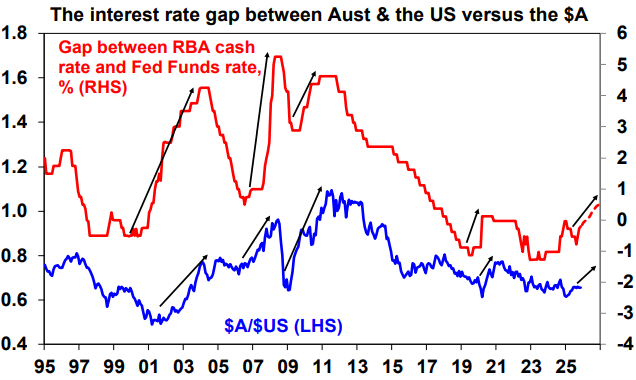
Major global economic events and implications
It was another quiet week for data in the US thanks to the partial government shutdown. Small business optimism fell slightly in September. Meanwhile, state-based data suggests that initial jobless claims remain low.

The US September quarter earnings reporting season is now around 92% done with 82% of companies beating expectations (against a norm of 76%) and earnings growth on track for 15.6%yoy, nearly double the consensus expectation at the start of the reporting season. Tech sector earnings are running up 28%yoy, followed by financials at 25%yoy. September quarter profits have generally surprised on the upside globally as well.
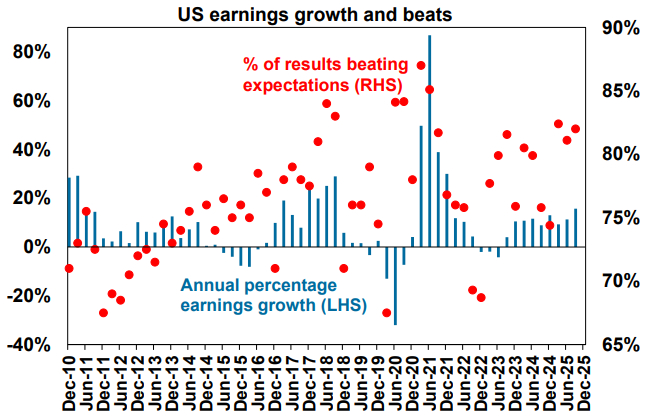
Unemployment rose further in the UK to 5%, as employment fell and wages growth slowed a bit, and September quarter GDP growth was just 0.1%qoq. This adds to the likelihood that the Bank of England will cut rates again in December with more rate cuts next year.
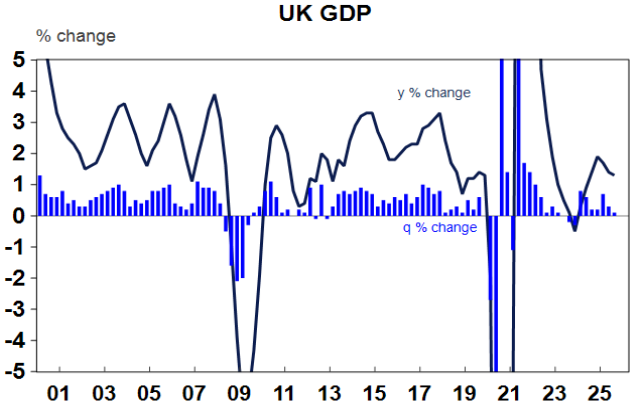
Chinese economic data for October remained softish with growth in industrial production slowing to 4.9%yoy, retail sales at 2.9%yoy and investment remaining negative with property investment down 14.7%.
Home prices continued to fall and credit growth also slowed further to 8.5%yoy from 8.7%yoy. Chinese data is probably still consistent with overall economic growth just below 5% this year, so consistent with incremental stimulus measures rather than any big bang policy easing.
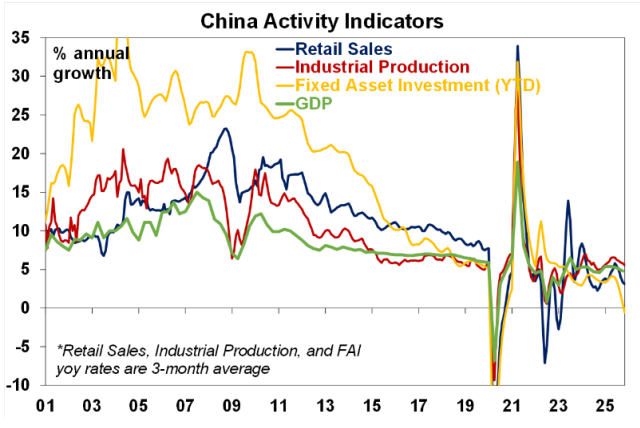
Meanwhile Chinese price deflation eased in October with consumer prices up 0.2%yoy as food and non-food prices rose with core inflation rising to 1.2%yoy from 1%yoy. This possibly reflects measures to reduce excess capacity but could also be due to Golden Week demand so may not be sustained. Producer price deflation also eased.

Australian economic events and implications
October jobs data surprised on the upside. After several softer than expected months, employment rose by 42,000, unemployment fell back to 4.3% and hours worked rose a solid 0.5%mom.
This won’t do anything to change the RBA’s assessment that the labour market is a “little tight”. However, it is worth noting that the surge in employment was largely accounted for by one state, NSW, the trend in annual jobs growth and growth in hours worked is continuing to slow and unemployment is continuing to trace out a gradual rising trend.

Our assessment is that the jobs market is best characterised as “balanced” rather than “tight”. Unemployment at 4.3% is around our guesstimate of NAIRU (the non-accelerating inflation rate of unemployment) rather than below it.
And as can be seen in the next chart, while the supply of workers (as proxied by the total labour force) is still trending up the demand for workers (as proxied by employment and job vacancies) appears to be flattening out notwithstanding the slight spike in October. The labour market was clearly tight around 2022-23 when labour demand was around labour supply but it’s a lot harder to say that now.
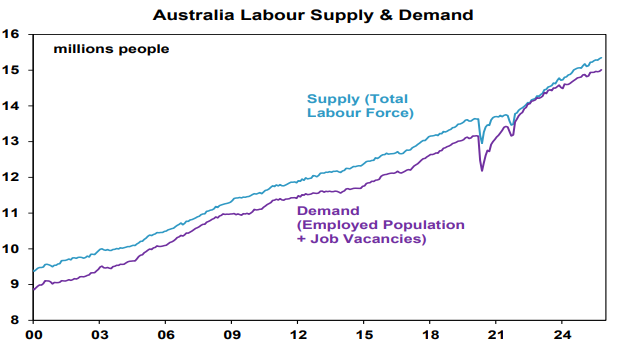
What’s more forward looking jobs data relating to job ads and vacancies continues to trend down with most warning of slower jobs growth ahead. Hiring plans in the NAB survey also point to slowing jobs growth and the risk remains high that as growth in non-market jobs (mainly in the “care economy”) slows down after booming, private sector jobs growth will be slow to fill the gap.

Consumer confidence as measured by the Westpac/MI survey surprisingly surged nearly 13% in November, despite less positive news on inflation and interest rates. However, the rise was largely driven by those who owned their own home outright and the alternative ANZ Roy Morgan confidence measure is painting a far more subdued picture. Time will tell which survey is right.
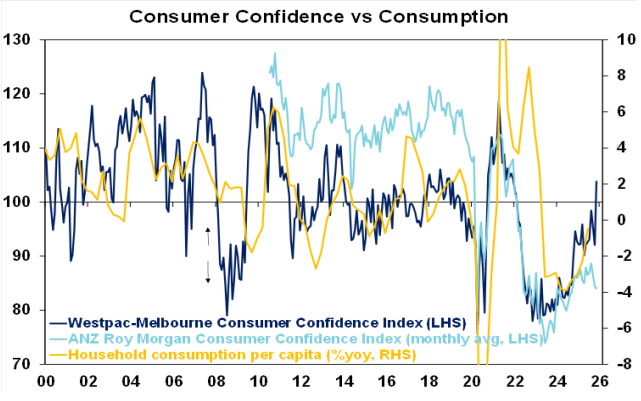
The Westpac/MI consumer survey also showed that home price growth expectations remain very strong. Perceptions as to whether now is a good time to buy a dwelling are well up from their lows but remain subdued.

Business confidence fell slightly in the October NAB survey and business conditions rose slightly but with both pointing to okay economic growth. The employment component still points to some slowing in jobs growth.

The good news is that cost and price pressures fell which along with the Melbourne Institute’s Inflation Gauge remaining subdued for trimmed mean inflation suggest that the rise in inflation seen in the September quarter may be more noise than signal.

Monthly visa data and net permanent and long-term arrivals data continue to provide a conflicting picture on the trend in net migration with the former pointing to a further fall in immigration but the latter suggesting a possible rebound.

September quarter housing finance surged nearly 10%qoq, driven by a surge in investor finance. This reflects the cut in mortgage rates and is consistent with the rebound in home prices seen this year. With the investor share of all loans getting back to levels last seen a decade ago, the likelihood of another round of “macro-prudential controls” to cool it down is rising.
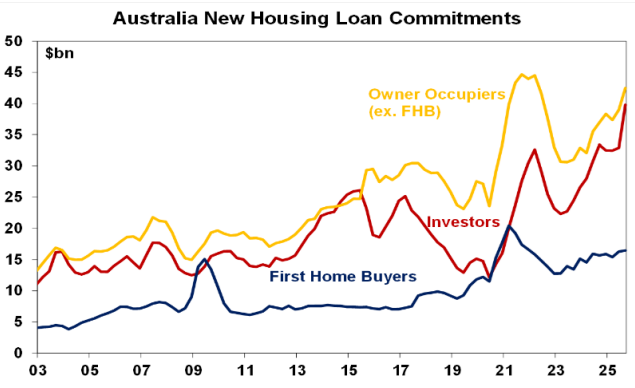
What to watch over the week ahead?
Business conditions PMIs for October for major countries, including Australia, to be released Friday, are expected to remain consistent with okay economic growth.
In the US the focus will be on the release of data delayed by the Government shutdown. The first of the major data to be released is likely to be the September payrolls and labour market report which is expected to show a 40,000 rise in jobs and unemployment remaining at 4.3%. Other official data is likely to follow over the next few weeks, but some stats for October will likely never be published – such as the household jobs and CPI reports - as the data was not collected.
But in the week ahead expect regional manufacturing conditions indexes and home builder conditions to remain subdued. If jobs data remains soft it will likely support the case for the Fed to cut rates again next month, but the absence of some October data for unemployment and the CPI may still leave it cautious going into its December meeting.
The Fed’s cautious approach in the face of “foggy conditions” will likely be reiterated in the minutes of the last Fed meeting (Wednesday).
Canadian inflation for October (Tuesday) is likely to show underlying inflation falling to 3%yoy.
UK underlying inflation for October (Wednesday) is likely to fall to around 3.4% yoy.
Japanese core inflation for October (Friday) is likely to rise back to around 1.6%yoy.
In Australia, September quarter wages growth is likely to be around 0.8% leaving annual growth at 3.4%yoy with the Fair Work Commission’s 3.5% boost to minimum and award wages impacting, albeit this was below last year’s 3.75% rise.
The minutes from the last RBA meeting (Tuesday) are likely to reiterate a cautious data dependent approach on the back of concerns about supply constraints.
Outlook for investment markets
Share markets remain at risk of a correction given stretched valuations, risks around US tariffs and the softening US jobs market.
But with Trump pivoting towards more market friendly policies and central banks, including the Fed and RBA, likely to cut rates further, shares are likely to provide reasonable gains on a 6-12 month horizon.
Bonds are likely to provide returns around running yield or a bit more as central banks continue to cut rates.
Unlisted commercial property returns are likely to improve as office prices have already had sharp falls in response to working from home.
Australian home prices are in an upswing on the back of lower interest rates and more support for first home buyers.
But it’s likely to be constrained a bit by poor affordability and indications that the RBA may be at or close to the low on rates.
Cash and bank deposits are expected to provide returns of around 3.5%, but they are likely to slow.
The $A is likely to be buffeted in the near term by the impact of US tariffs but may break higher with the Fed looking like it will cut more than the RBA. Undervaluation should support it on a medium-term view with fair value around $US0.73.

5 topics
